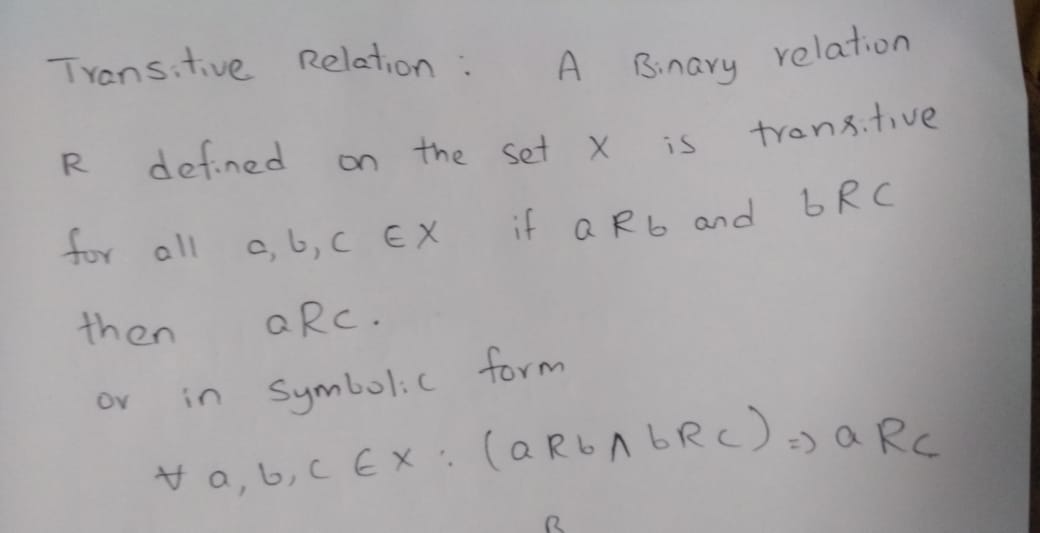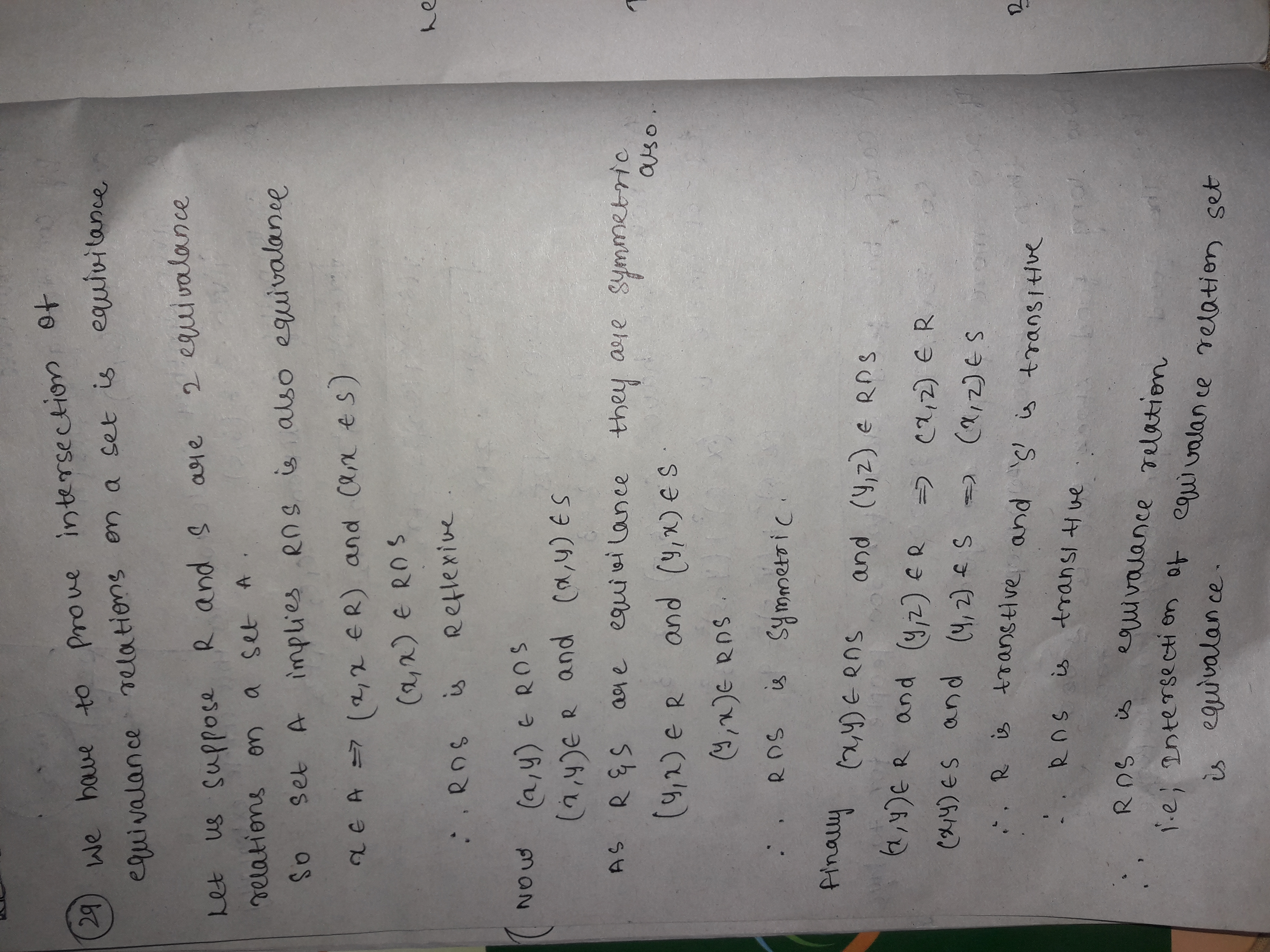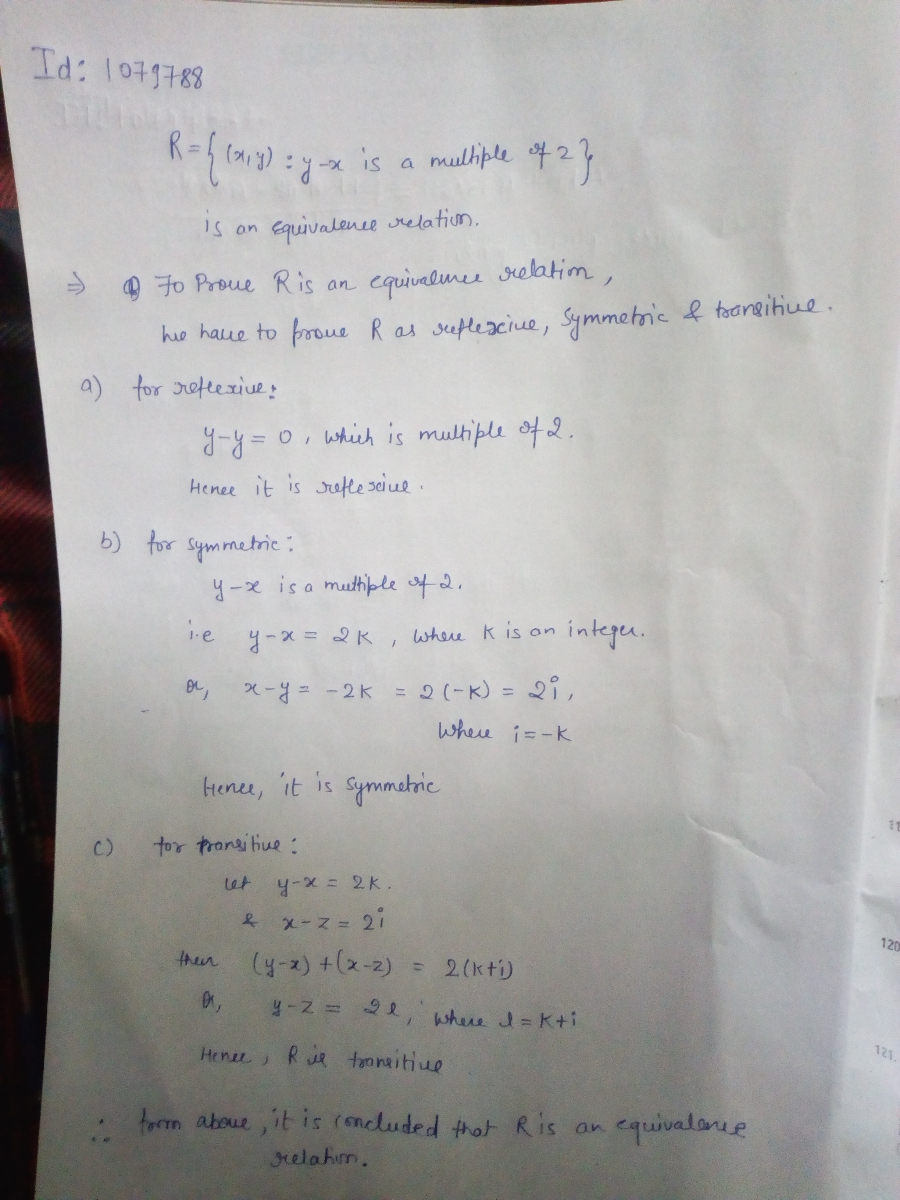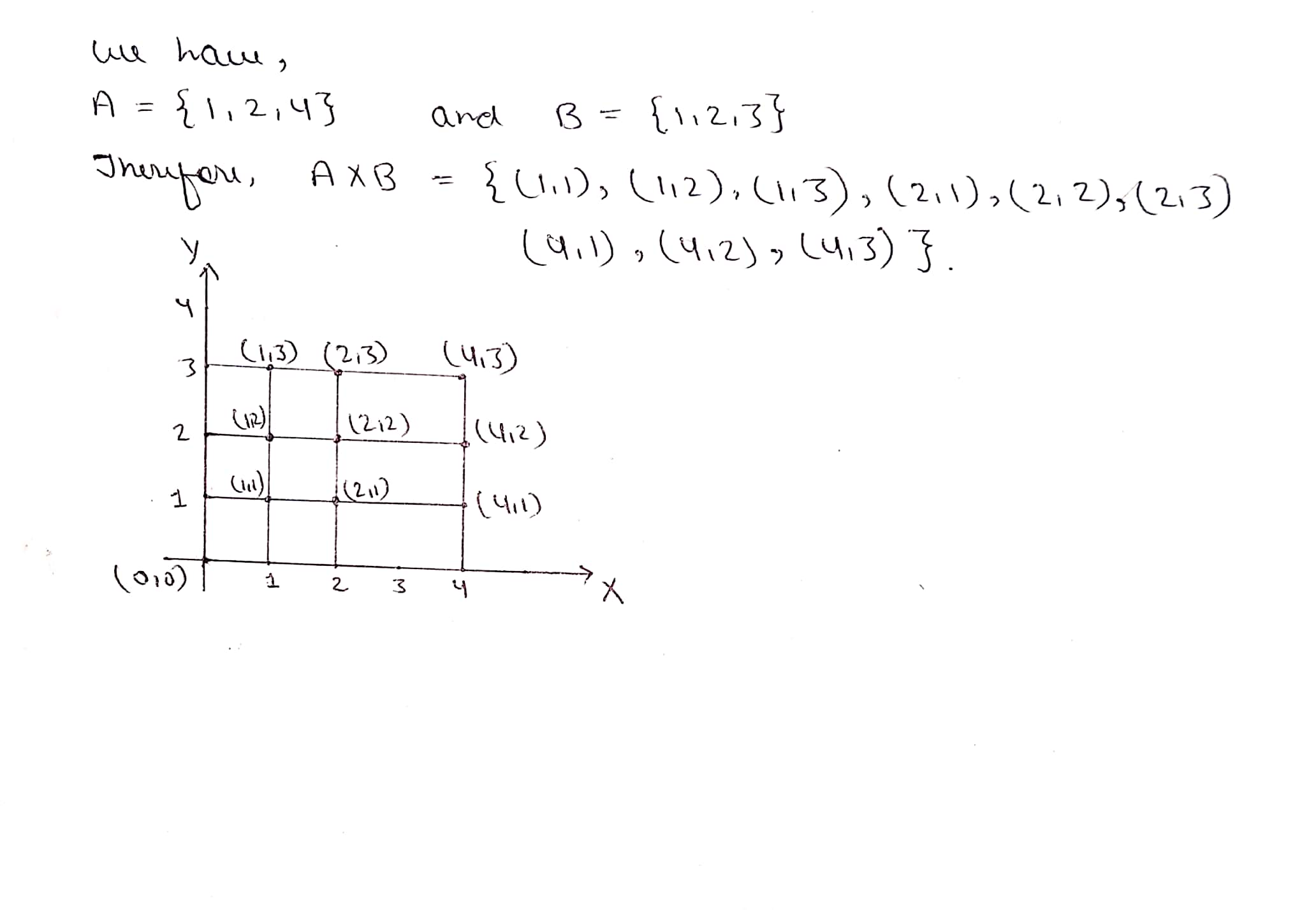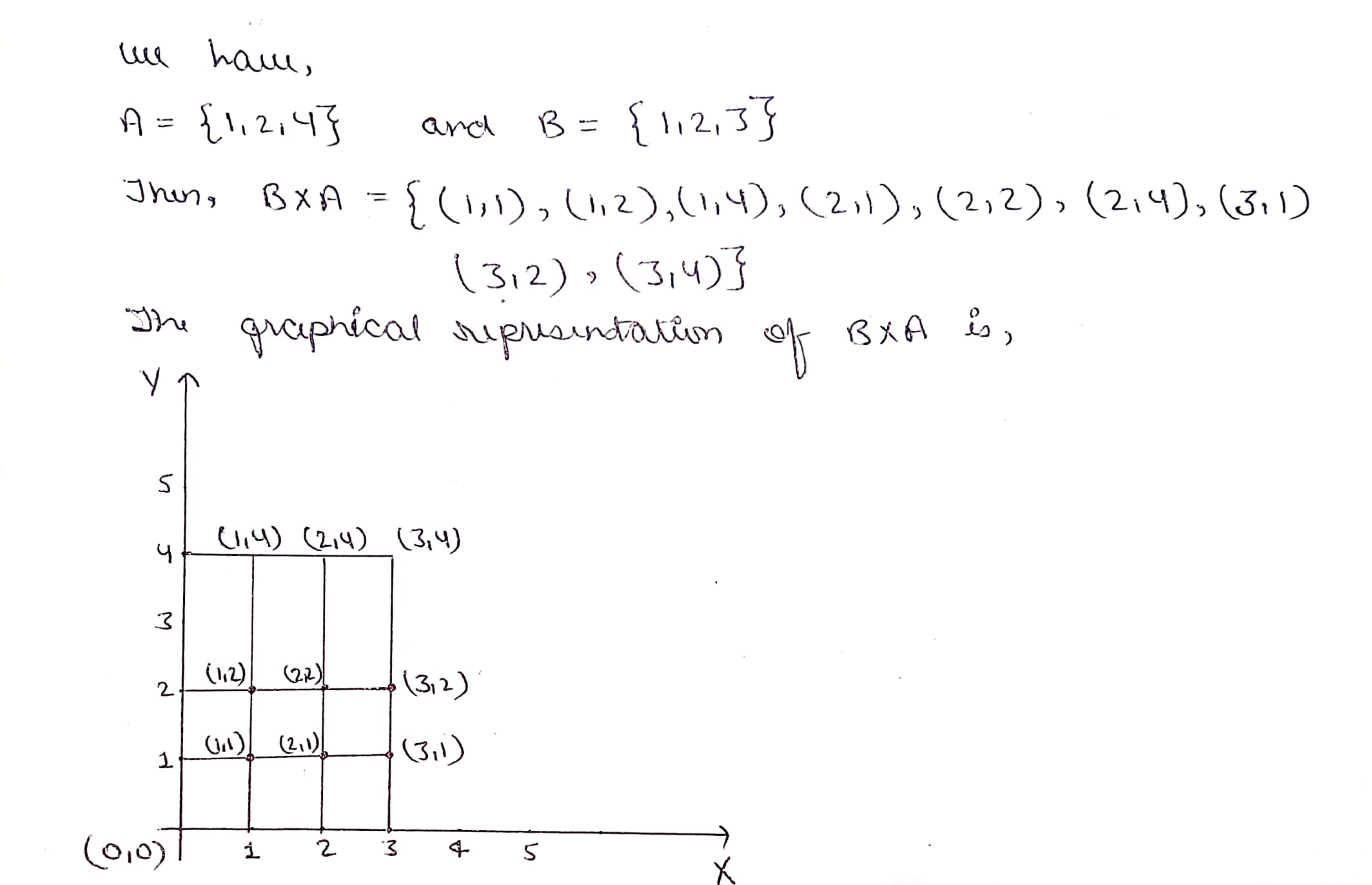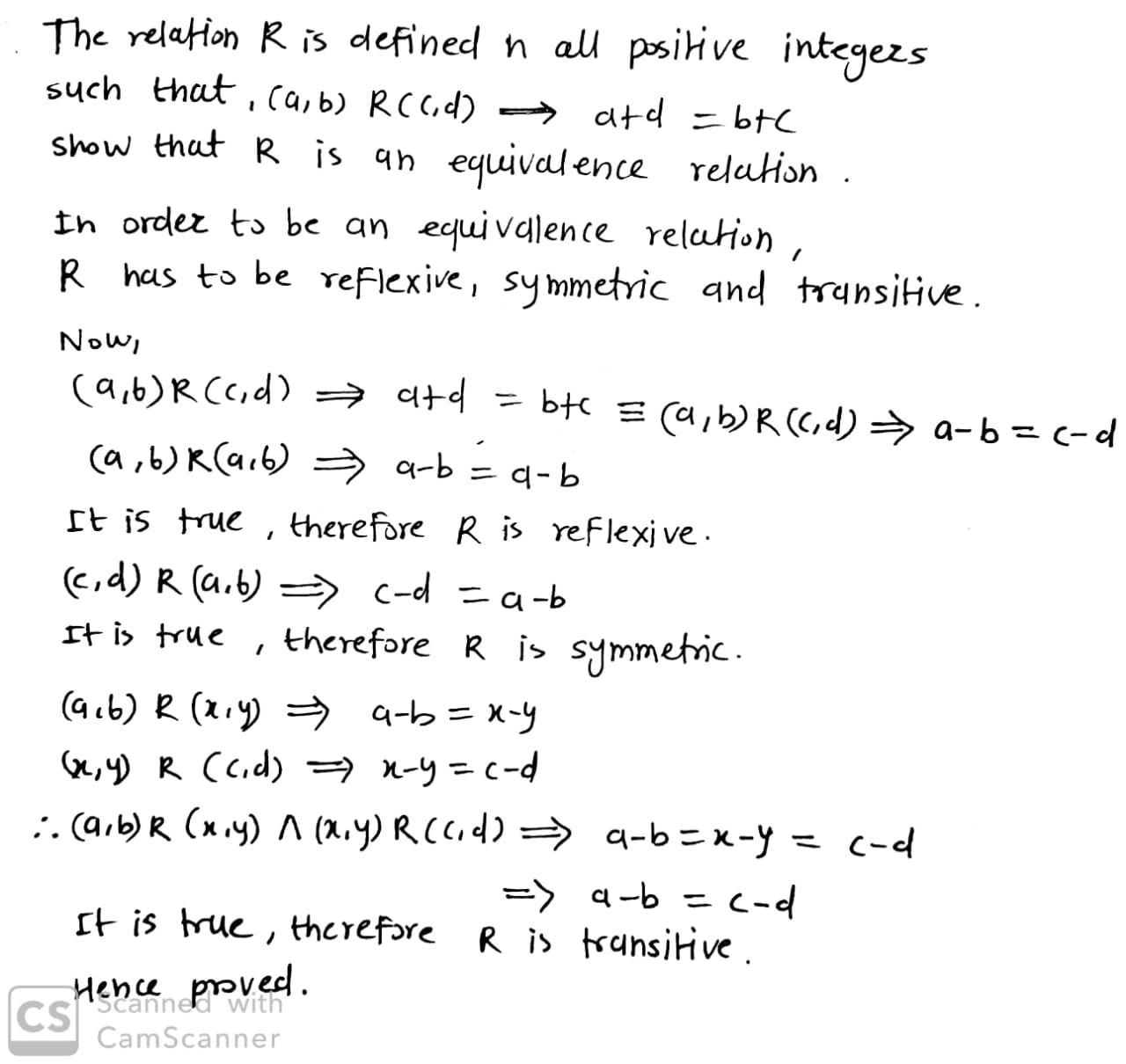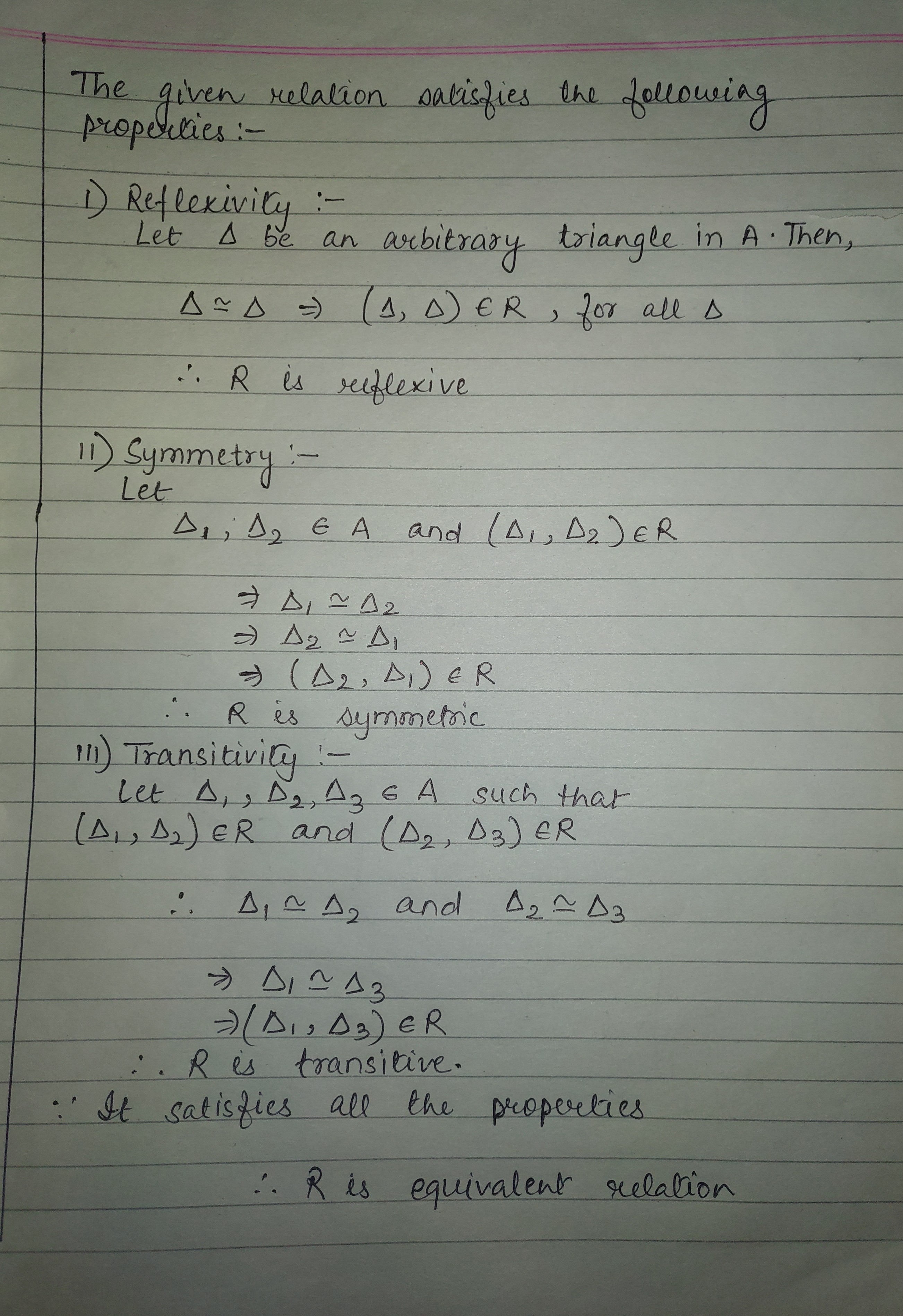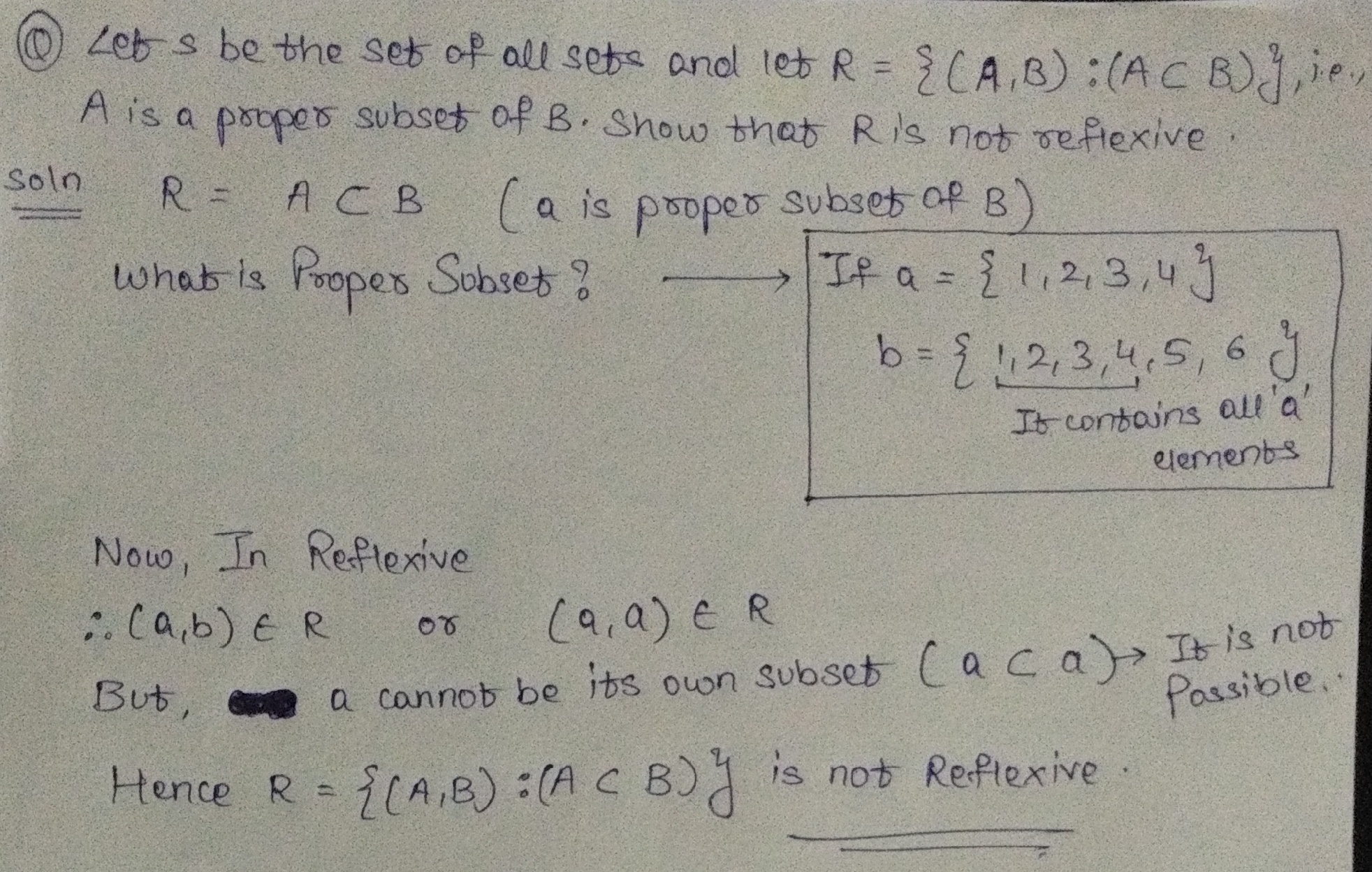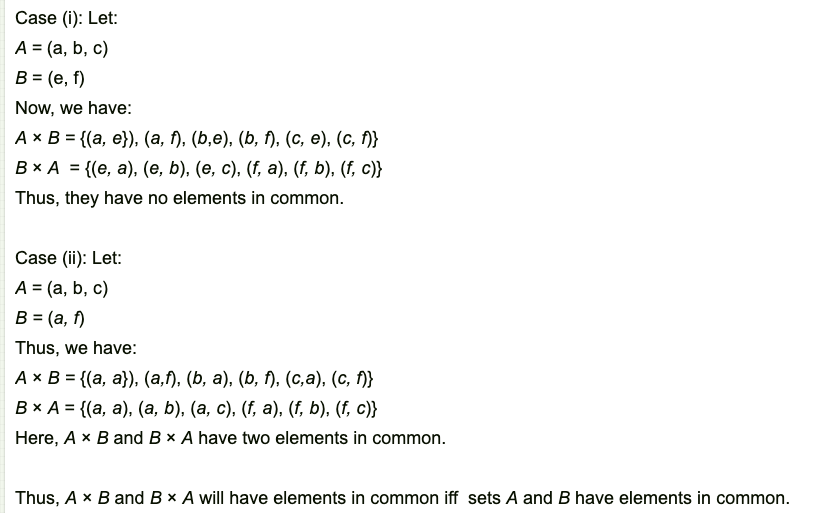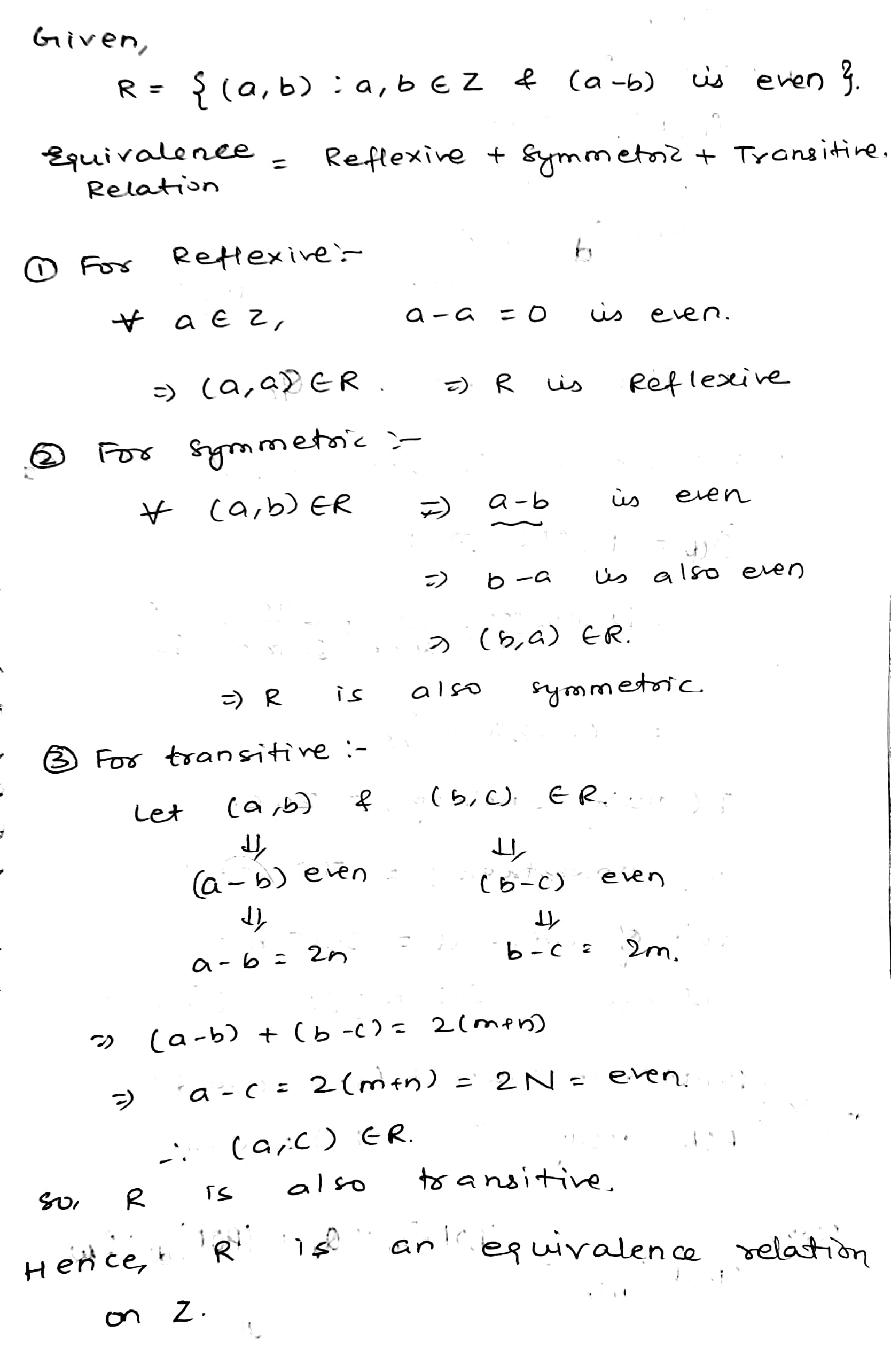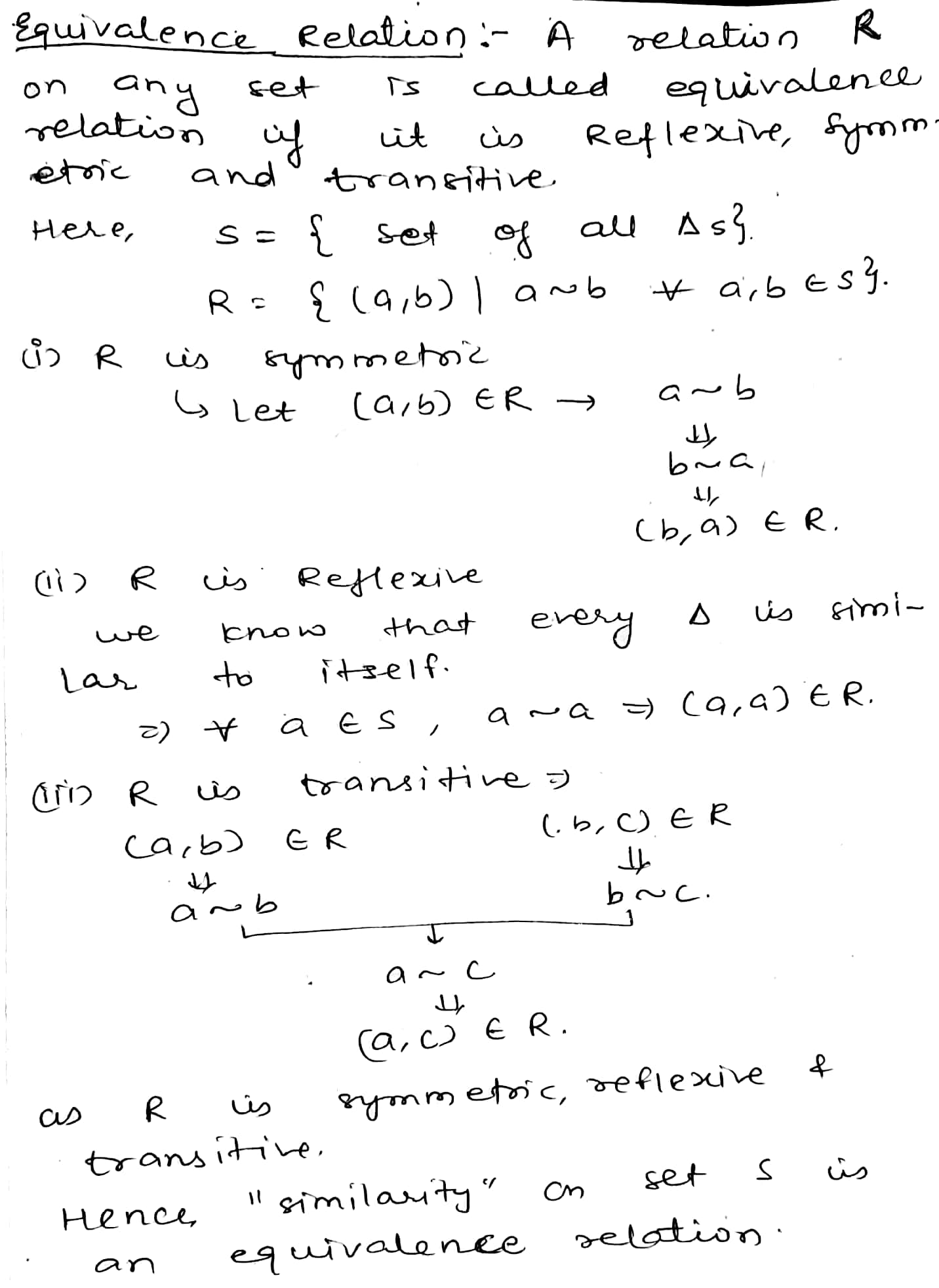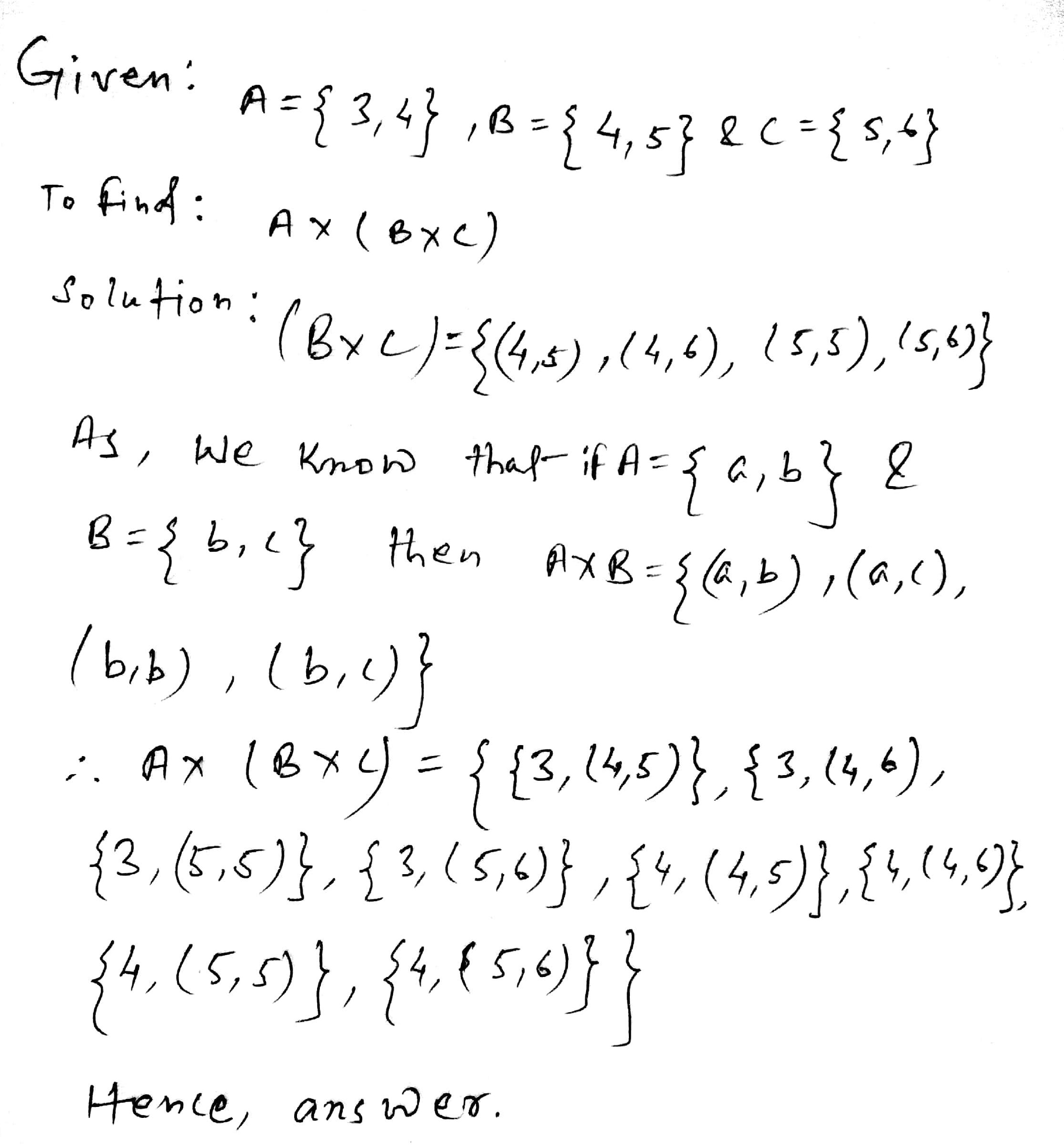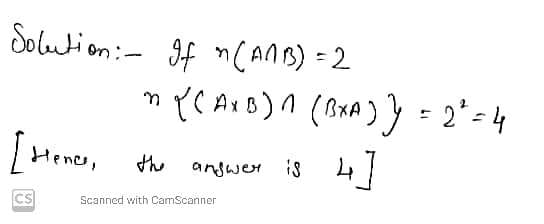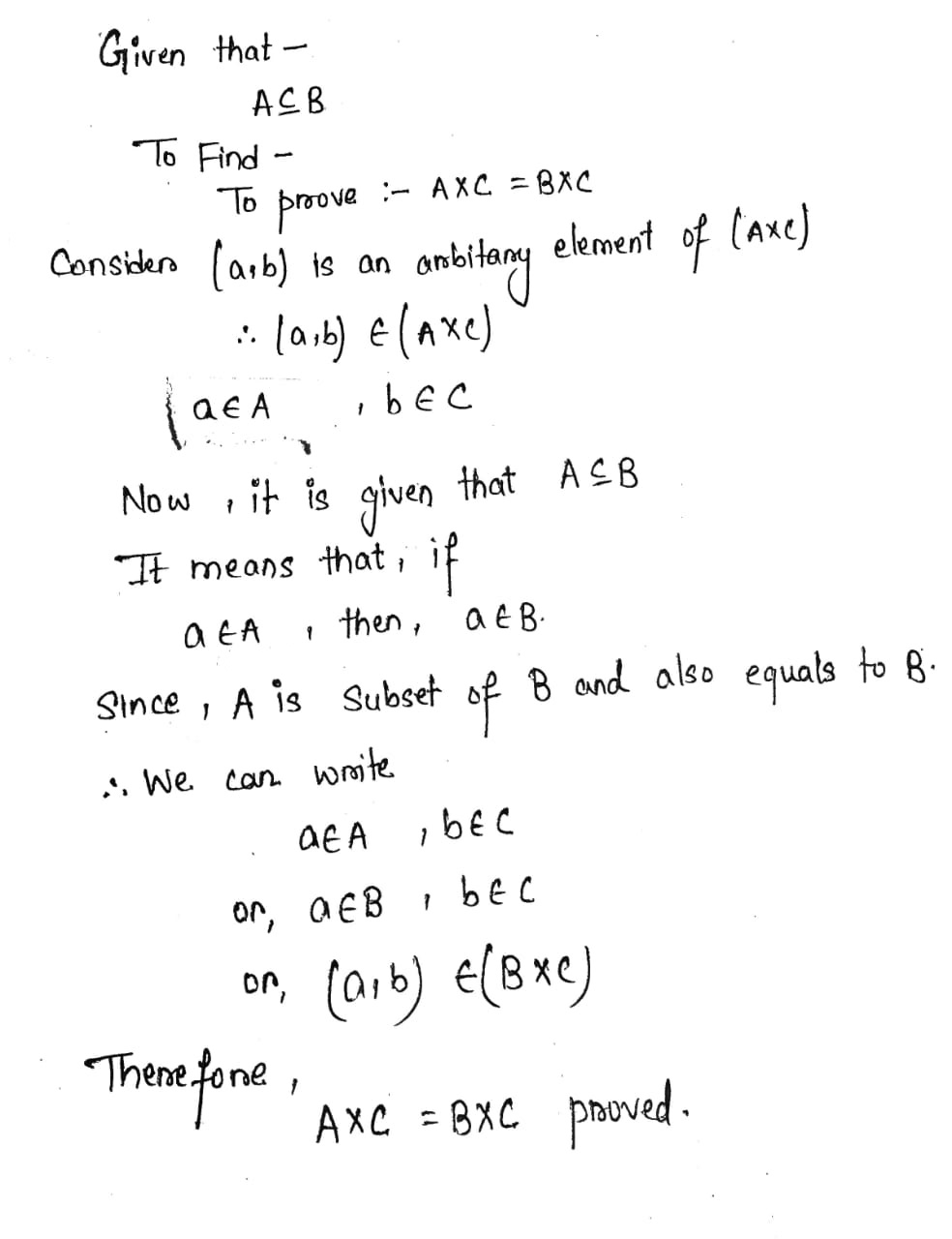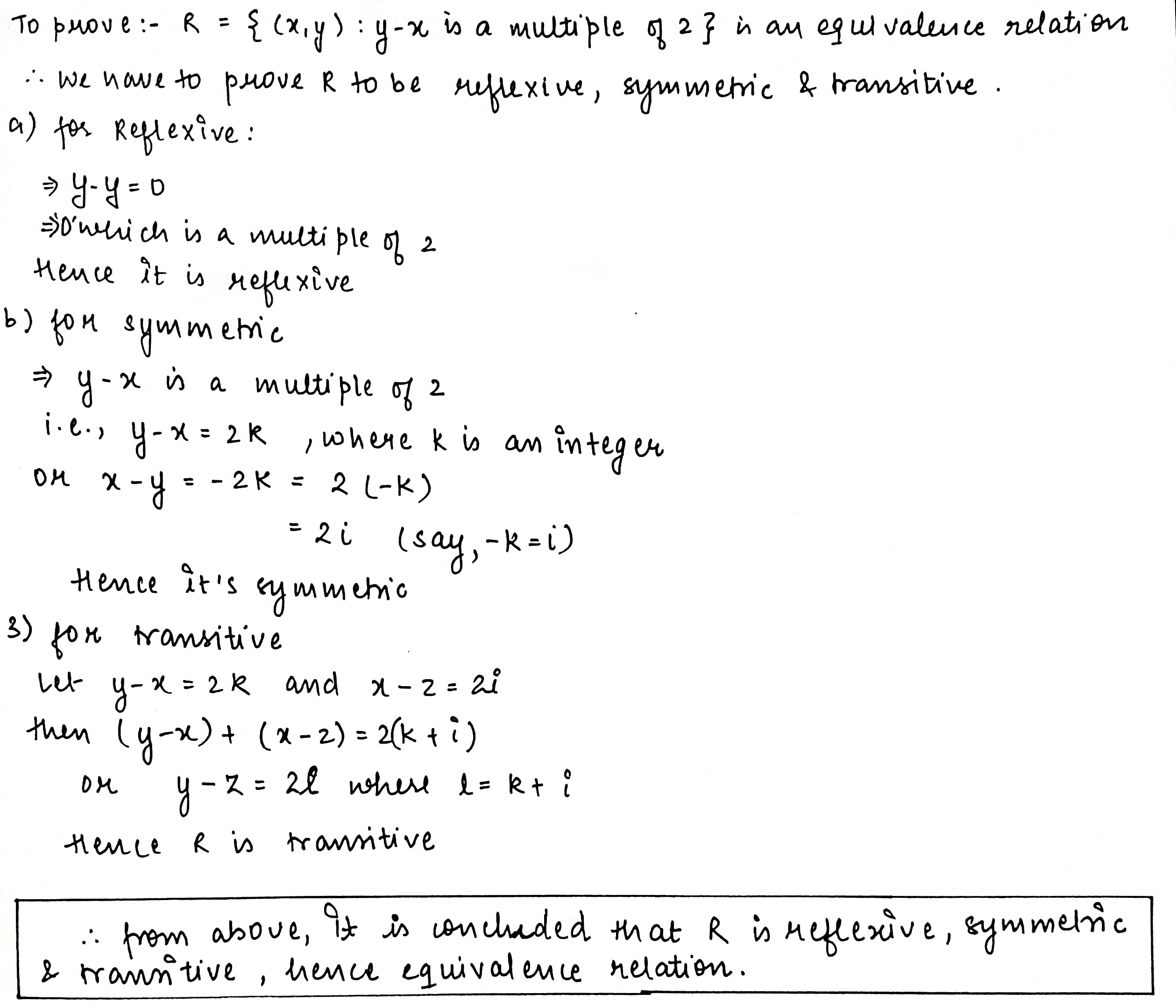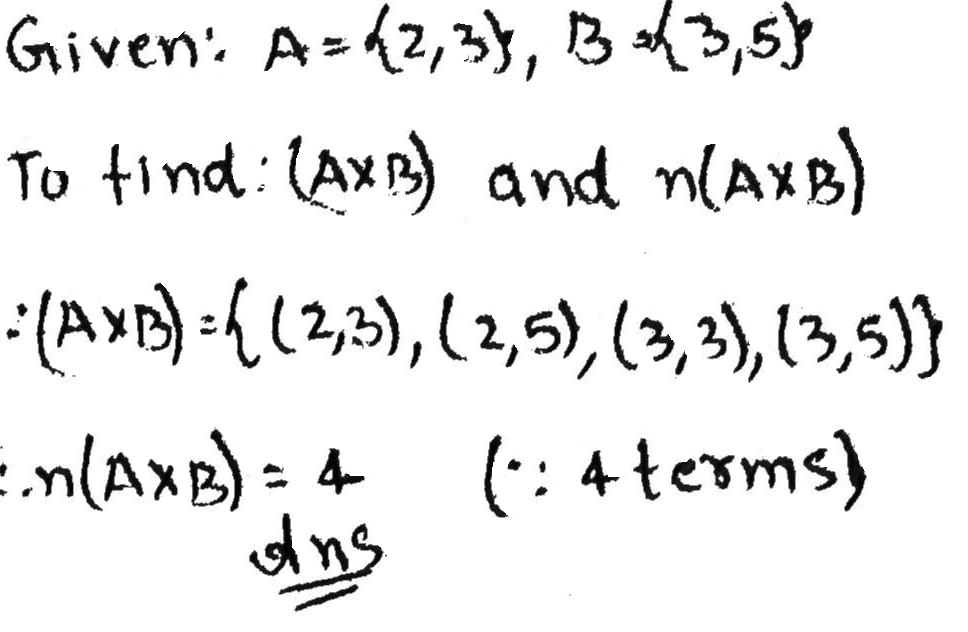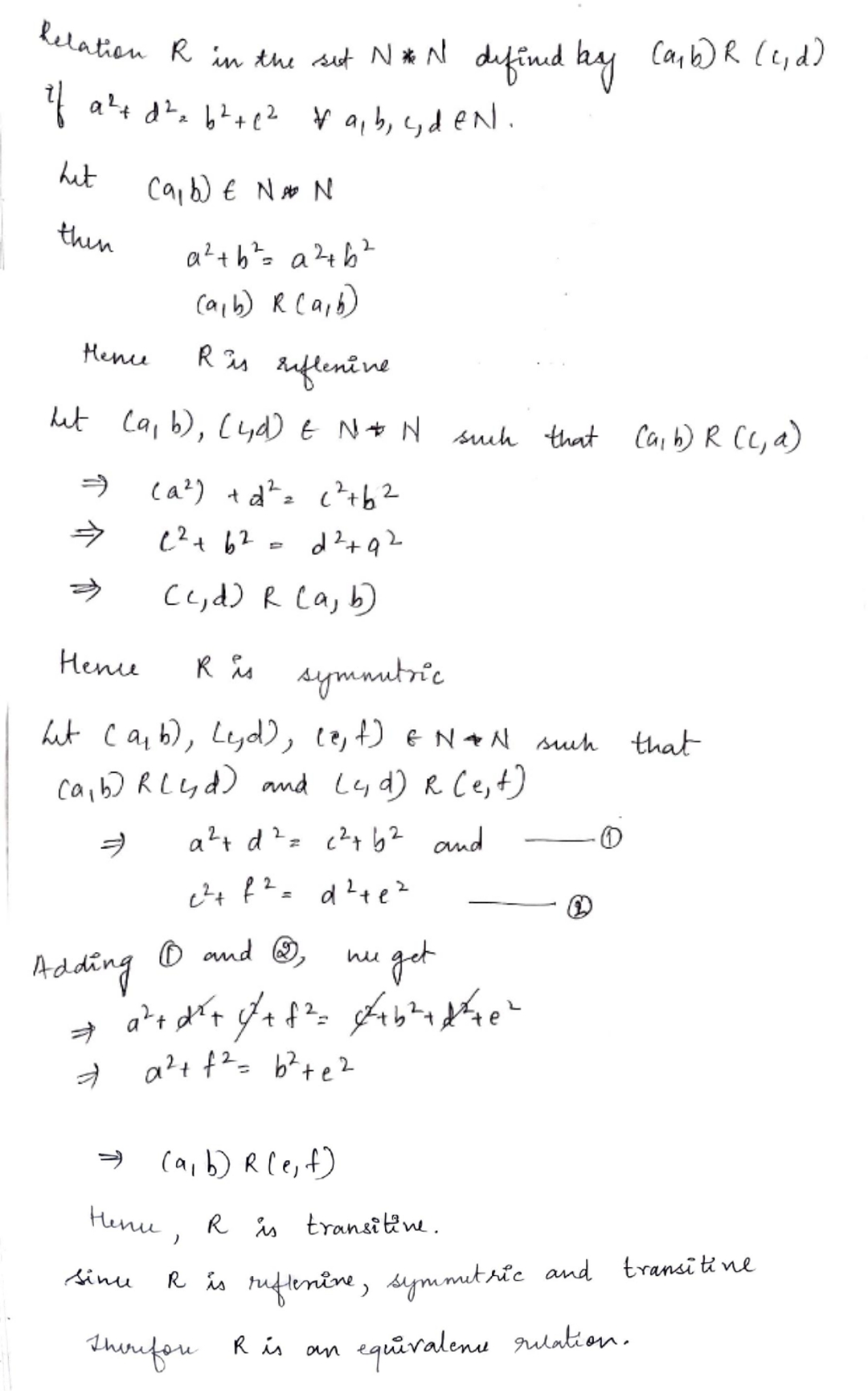Relations - Class 11 Commerce Applied Mathematics - Extra Questions
If $$A$$ has $$3$$ elements and $$B$$ has $$5$$ elements then $$A \times B$$ has ___elements.
Is inclusion of a subset in another, in the context of a universal set, an equivalence relation in the family of subsets of the sets? Justify your answer.
Show that every relation which is symmetric and transitive need not to be reflexive.
Let R be a relation on Z (the set of integers) defined as $$mRn$$, $$\:iff\:m\leq n \forall m,n \in Z$$ then R is anti symmetric.If true enter 1 else enter 0
If the set $$A$$ has $$3$$ elements and the set $$B = \{ 3, 4, 5 \}$$ then find the number of elements in $$( A \displaystyle \times B )$$?
Determine which of the following are reflexive relations on set $$A= \{ 1, 2, 3\}$$.- $$\displaystyle R_{1}=\{(1,1),(2,2),(3,3),(2,1)\}$$
- $$R_{2}=\{(1,1),(3,3),(2,1),(3,2)\}$$.
If $$R_1$$ is reflexive then answer $$1$$ and if $$R_2$$ is reflexive then answer $$2$$.
- $$\displaystyle R_{1}=\{(1,1),(2,2),(3,3),(2,1)\}$$
- $$R_{2}=\{(1,1),(3,3),(2,1),(3,2)\}$$.
If $$R_1$$ is reflexive then answer $$1$$ and if $$R_2$$ is reflexive then answer $$2$$.
If $$\displaystyle A\times B = \{(a, x), (a, y), (b, x), (b, y)\}$$ Find $$A$$ and $$B$$.
Let $$A = \{1, 2\}, B = \{1, 2, 3, 4\}, C = \{5, 6\}$$ and $$D = \{5, 6, 7, 8\}$$ Verify that
(i) $$\displaystyle A\times \left ( B\cap C \right )=\left ( A\times B \right )\cap \left ( A\times C \right )$$
(ii) $$\displaystyle A\times C$$ is a subset of $$\displaystyle B\times D$$
Let $$A = \{1, 2\}$$ and $$B = \{3, 4\}$$. Write $$\displaystyle A\times B$$ and find how many subsets will $$\displaystyle A\times B$$ have? List them.
If $$=A \{-1, 1\}$$ then find $$\displaystyle A\times A\times A$$.
Show that the relation $$R$$ in the set $$A$$ of all the books in a library of a college, given by $$R=\left\{(x, y):x\ and \ y have \ same \ number \ of \ pages \right\}$$ is an equivalence relation.
Given an example of a relation. Which is
(i) Symmetric but neither reflexive nor transitive.(ii) Transitive but neither reflexive nor symmetric.(iii) Reflexive and symmetric but not transitive.(iv) Reflexive and transitive but not symmetric.(v) Symmetric and transitive but not reflexive.
Show that the relative $$R$$ in the set $$\left\{1, 2, 3\right\}$$ given by $$R=\left\{(1, 2), (2, 1)\right\}$$ is symmetric but neither reflexive nor transitive.
Determine whether each of the following relations are reflexive, symmetric and transitive:
(i) Relation $$R$$ in the set $$A = \left\{1, 2, 3, ..., 13, 14\right\}$$ defined as$$\ \ \ \ \ \ \ \ \ \ \ R = \left\{(x, y) : 3x - y = 0\right\}$$(ii) Relative $$R$$ in the set $$N$$ of natural numbers defined as $$\ \ \ \ \ \ \ \ \ \ \ R=\left\{(x, y):y=x+5\ \text{and} x < 4\right\}$$
(iii) Relation $$R$$ in the set $$A=\left\{1, 2, 3, 4, 5, 6\right\}$$ as $$\ \ \ \ \ \ \ \ \ \ \ R=\left\{(x, y):y \text{is divisible by} x\right\}$$(iv) Relative $$R$$ in the set $$Z$$ of all integers defined as $$\ \ \ \ \ \ \ \ \ \ \ R=\left\{(x, y): x-y\text{ is an integer}\right\}$$(v) Relation R in the set A of human beings in a town at a particular time given by $$\ \ \ \ (a) R=\left\{(x, y):x \text{and} y \text{work at the same place }\right\}$$$$\ \ \ \ (b) R=\left\{(x, y):x \text{and} y \text{live in the same locality}\right\}$$
$$\ \ \ \ (c) R=\left\{(x, y):x \text{is exactly} 7 \text{cm taller than} y\right\}$$
$$\ \ \ \ (d) R=\left\{(x, y): x \text{is wife of} y\right\}$$
$$\ \ \ \ (e) R=\left\{(x, y): x \text{ is father of} y \right\}$$
(ii) Relative $$R$$ in the set $$N$$ of natural numbers defined as
$$\ \ \ \ \ \ \ \ \ \ \ R=\left\{(x, y):y=x+5\ \text{and} x < 4\right\}$$
(iii) Relation $$R$$ in the set $$A=\left\{1, 2, 3, 4, 5, 6\right\}$$ as
$$\ \ \ \ \ \ \ \ \ \ \ R=\left\{(x, y):y \text{is divisible by} x\right\}$$
(iv) Relative $$R$$ in the set $$Z$$ of all integers defined as
$$\ \ \ \ \ \ \ \ \ \ \ R=\left\{(x, y): x-y\text{ is an integer}\right\}$$
Check whether the relative $$R$$ in $$\textbf{R}$$ defined by $$R=\left\{(a, b):a\leq b^3\right\}$$ is reflexive, symmetric or transitive.
Show that the relative $$R$$ in $$\textbf{R}$$ defined as $$R=\left\{(a, b):a \leq b\right\}$$, is reflexive and transitive but not symmetric.
If a set contains $$m$$ elements and $$B$$ contains $$n$$ elements, then find the number of elements in $$A\times B$$.
Is it true that the every relation which is symmetric and transitive is also reflexive ? Give reasons.
What is the distinction between a relation and function and when do you call a relation reflexive, symmetric and transitive ?
Given a relation $$R ={(1,2), (2, 3)}$$ on the set of natural numbers, add a minimum number of ordered pairs so that the enlarged relation is symmetric, transitive and reflexive.
If $$P = {(1, 2, 3)}$$ and $$Q = (4) $$find sets $$P \times Q and Q\times P$$
Given A = {2, 3, 4}, B = {2, 5, 6, 7}.
Construct an example of each of the following
(i) an injective mapping from A to B.
(ii) a mapping from A to B which is not injective.
(iii) a mapping from B to A.
If $$n(A)=4,n(B)=3,n(A\times B\times C)=24$$, then $$n(C)=$$
Which of the following is an equivalence relation?
1)$$x<y$$
2)$$x>y$$
3)$$x-y$$ is divisible by $$5$$
4)$$x$$ divides $$y$$
Let A = {0, 1, 2, 3 } and define a relation R as followsR = {(0,0), (0,1), (0,3), (1,0), (1,1), (2,2), (3,0), (3,3)}.Is R reflexive, symmetric and transitive ?
Let $$A = \{6, 8\},$$ $$B = \{1, 3, 5\}$$ and $$R = \{(a, b): a \, \in \, A , \, b \, \in \, B , \, a - b \, is \, even\}$$.
Show that R is an empty relation from A to B.
Let $$A = \{1, 2\}$$ and $$B = \{3, 4\}$$. Write $$A \times B$$. How many subsets will $$A \times B$$ have?
If $$A=\left\{1,2\right\}$$, from the set $$A\times A\times A$$.
what is Transitive relation?
If A={1,2,3}, B={3,4}, C={4,5,6}. Find $$A\times (B\ \cap \ C)$$
Let $$S$$ be a relation on the set $$R$$ of all real numbers defined by $$S=\left\{ \left( a,b \right) \in R\times R:{ a }^{ 2 }+{ b }^{ 2 }=1 \right\} $$. Prove that $$S$$ is not an equivalence relation on $$R$$.
Show that the relation $$\ge$$ on the set $$\mathbb{R}$$ of all real numbers is reflexive and transitive but not symmetric.
Let $$n$$ be a fixed positive integer. Define a relation $$R$$ on $$Z$$ as follows:
$$(a,b)\in R\Leftrightarrow $$ $$n$$ divides $$ a-b$$.
Show that $$R$$ is an equivalence relation on $$Z$$.
Let $$O$$ be the origin. We define a relation between two points $$P$$ and $$Q$$ in a plane, if $$OP=OQ$$. Show that the relation, so defined is an equivalence relation.
Define an equivalence relation.
Define a reflexive relation.
Define a transitive relation.
Define a symmetric relation.
Write the smallest equivalence relation on the set $$A=\left\{ 1,2,3 \right\} $$.
Is $$*$$ defined on the set {1, 2, 3, 4, 5} by $$a*b$$ = LCM of a and b, a binary operation ? Justify your answer.
Find the number of reflexive relations from set $$A$$ to $$A$$, defined as $$A = {a, b, c}$$.
Each of the following defines a relations a relation on $$N$$:
$$x+4y=10\ x,y\ \in \ N$$
Determine which of the above relations are reflexive, symmetric and transitive,
Each of the following defines a relations a relation on $$N$$:
$$xy$$ is square of an integer $$x,y\ \in \ N$$.
Determine which of the above relations are reflexive, symmetric and transitive,
Each of the following defines a relations a relation on $$N$$:
$$x+y=10,x,y\ \in N$$
Determine which of the above relations are reflexive, symmetric and transitive,
Let $$n$$ be a fixed positive integer. Define a relation $$R$$ in $$Z$$ as follows $$\forall a, b \in Z. aRb$$ if and only $$a-b$$ is divisible by $$n$$. Show that $$R$$ is an equivalence relation.
If $$A=\left\{1,2,3,4 \right\}$$, define relation on $$A$$ which have properties of being.
reflexive, symmetric and transitive.
If $$A=\left\{1,2,3,4 \right\}$$, define relation on $$A$$ which have properties of being.
symmetric but neither reflective nor transitive.
If $$A=\left\{1,2,3,4 \right\}$$, define relation on $$A$$ which have properties of being.
reflexive, transitive but not symmetric.
Set A has m elements an set B has n elements. If the total number of subsets of A is $$112$$ more than total numbers of subsets of B, then the value of $$m\times n$$ is
Let $$A=\left\{1,2,3,...9\right\}$$ and $$R$$ be the relation in $$A\times A$$ defined by $$(a,b)\ R\ (c,d)$$ if $$a+b=b+c$$ for $$(a,b),(c,d)$$ in $$A\times A$$. Prove that $$R$$ is an equivalence relation and also obtain the equivalent class $$[(2,5)]$$.
Let $$R$$ be a relation on $$Z$$ (the set of integers) defined as $$mRn,iffm\le n\forall m,n\epsilon Z$$ then $$R$$ is anti symmetric.
In the set of triangles in a plane the relation 'is similar to' is an equivalence relation. Prove .
In the set of all positive integers show that the relation '>' is not an equivalence relation.
Show that the relation R in $$N\times N$$ defined by $$(a, b) R (c, d)$$ if $$ad=bc$$ is an equivalence relation.
The relation 'is a subset of' in a set of sets is not an equivalence relation. Prove.
Show that the relation 'a R b if and only if $$a-b$$ is an even integer defined on the Z of integers is an equivalence relation.
Let L be the set of all lines in XY-plane and R be the relation in L defined as $$R=\left \{ (L_{1}, L_{2}):L_{1} \ is \ parallel \ to\ L_{2} \right \}$$. Show that R is an equivalence relation. Find the set of all lines related to the line $$y=2x$$
Give a non-empty set $$X$$. Consider $$P(X)$$, which is the set of all subsets of $$X$$. Define the relation $$R$$ in $$P(X)$$ as follows:
For subsets $$A$$ and $$B$$ in $$P(X)$$, $$A R B$$ if $$A\subset B$$, is $$R$$ an equivalence relation on $$P(X)$$?
Justify your answer.
An "Anti-symmetric" relation need not be reflexive relation: give an example.
Let R and S be two equivalence relations on set A. Prove that $$R\cap S$$ is an equivalence relation.
If in $$N\times N$$, $$R$$ is a relation defined by the formula $$(x, y) R(p, q)$$ if and only if $$x+q=y+p$$, show that R is an equivalence relation.
The relation $$R$$ and $$R'$$ are symmetric in the set $$A$$, then show that $$R\cup R'$$ and $$R\cap R'$$ are symmetric.
Let $$A=\{1, 2, 3\}$$. Then show that the smallest equivalence relation on $$A$$ is $$\{(1, 1), (2, 2), (3, 3)\}$$
For each set of ordered pairs below, state whether it is a function or not giving reasons(i){(3, 2), (4, 2), (5, 2)}
if a function enter 1 else 0
Let $$\displaystyle R=\left \{ \left ( a,a \right ),\left ( b,c \right ),\left ( a,b \right ) \right \}$$ be a relation on a set $$\displaystyle A=\left \{ a,b,c \right \}.$$ Then the minimum number of ordered pairs which when added to R make it an equivalence relation are ...
Given $$A = \{5, 6, 7\}$$ and $$B = \{3, 4\}$$. Form all possible ordered pairs and write the total number of ordered pairs formed. So that the first component is from B and second is from A.Find the total number of such pairs.
Let $$R$$ be relation on I defined as mRn iff $$\displaystyle m\leq n.$$ Check if $$R$$ is an equivalence relation.
Given $$A = \{5, 6, 7\}$$ and $$B = \{3, 4\}$$. Form all possible ordered pairs and write the total number of ordered pairs formed so that the first component is from set A and second component is from set B.
What is the total number of such pairs?
If $$M=\{x : x \,\,\epsilon\,\, N, 1 < x \leq 4\}$$ and $$N = \{y : y\,\,\epsilon\,\,W, y < 3\}$$; find : $$n(M$$ $$\times$$ $$M)$$
If $$n(A) = m$$ and $$n(B) = n$$ ; then $$n(A \times B) = mn$$.What is the value of $$n(A \times B) = mn$$. if $$m = 6$$ and $$n = 8$$
The following relations are defined on the set of real numbers check them for R,S,T.
aRb iff $$\displaystyle \left | a-b \right |> 0$$
The following relations are defined on the set of real numbers check them for Reflexivity,Symmetry,Transitivity.
$$\displaystyle 1+ab> 0$$
Let S be the set of all points in a plane. Let R be a relation on S such that for any two points a and b, a R b iff b is within 1 centimetre from a. Check R for reflexivity, symmetry and transitivity.
If $$\displaystyle \alpha ,\beta $$ be straight lines in a plane, then check $$\displaystyle R_{1}\:and\:R_{2}$$ for being reflexive, symmetric and transitive $$\displaystyle \alpha R_{1} \beta\:if\:\alpha \perp \beta\:and\:\alpha R_{2}\beta\:if\:\alpha \mid \mid \beta .$$
reflexive, transitive but not symmetric.
Let $$R$$ be the equivalence relation in the set $$A = {0, 1, 2, 3, 4, 5}$$ given by $$R = {(a, b) : 2\ divides (a - b)}$$. Write the equivalence class [0].
Let $$T$$ be the set of all triangles in a plane with $$R$$ a relation in $$T$$ given by $$\displaystyle R=\left \{ (T_{1},T_{2}) \right \}:T_{1}$$ congruent to $$\displaystyle T_{2}$$}. Show that $$R$$ is an equivalence relation.
Determine whether the following relation is reflexive, symmetric and transitive
Relative $$R$$ in the set $$N$$ of natural numbers defined as $$R=\left\{(x, y):y=x+5 and x < 4\right\}$$
enter 1-Reflexive
2-Symmetric
3-Transitive
4-Equivalence
5-None
Relation R in the set A of human beings in a town at a particular time given by $$R=\left\{(x, y):x \, and \, y \, live \, in \, the \, same \, locality\right\}$$
enter 1-reflexive and transitive but not symmetric 2-reflexive only 3-Transitive only 4-Equivalence 5-None
enter 1-reflexive and transitive but not symmetric
2-reflexive only
3-Transitive only
4-Equivalence
5-None
Relation R in the set A of human beings in a town at a particular time given by $$R=\left\{(x, y):x \, is \, exactly \, 7 \, cm \, taller \, than \, y\right\}$$
enter 1-reflexive and transitive but not symmetric 2-reflexive only 3-Transitive only 4-Equivalence 5-Neither reflexive, nor symmetric, nor transitive
enter 1-reflexive and transitive but not symmetric
2-reflexive only
3-Transitive only
4-Equivalence
5-Neither reflexive, nor symmetric, nor transitive
Determine whether each of the following relations are reflexive, symmetric and transitive
Relation $$R$$ in the set $$A=\left\{1, 2, 3, 4, 5, 6\right\}$$ as $$R=\left\{(x, y):y \, \text{is divisible by} x\right\}$$
enter 1-reflexive and transitive but not symmetric 2-reflexive only 3-Transitive only 4-Equivalence 5-None
Relation $$R$$ in the set $$A$$ of human beings in a town at a particular time given by $$R=\left\{(x, y): x \, is \, wife \, of \, y\right\}$$
enter 1-reflexive and transitive but not symmetric 2-reflexive only 3-Transitive only 4-Equivalence 5-Neither reflexive, nor symmetric, nor transitive
enter 1-reflexive and transitive but not symmetric
2-reflexive only
3-Transitive only
4-Equivalence
5-Neither reflexive, nor symmetric, nor transitive
Relation $$R$$ in the set $$Z$$ of all integers defined as $$R=\left\{(x, y): (x-y) \, is \, an \, integer\right\}$$
enter 1-reflexive and transitive but not symmetric 2-reflexive only 3-Transitive only 4-Equivalence 5-None
enter 1-reflexive and transitive but not symmetric
2-reflexive only
3-Transitive only
4-Equivalence
5-None
Show that the relative $$R$$ in the set $$A=\left\{1, 2, 3, 4, 5\right\}$$ given by $$R=\left\{(a, b):|a-b| \text{ is even} \right\}$$, is an equivalence relation. Show that all the elements of $$\left\{1, 3, 5\right\}$$ are related to each other and all the elements of $$\left\{2, 4\right\}$$ are related to each other. But no element of $$\left\{1, 3, 5\right\}$$ is related to any element of $$\left\{2, 4\right\}$$.
Relation R in the set A of human beings in a town at a particular time given by $$ R=\left\{(x, y):x \, and \, y \, work \, at \, the \, same \, place \right\}$$
enter 1-reflexive and transitive but not symmetric 2-reflexive only 3-Transitive only 4-Equivalence 5-None
enter 1-reflexive and transitive but not symmetric
2-reflexive only
3-Transitive only
4-Equivalence
5-None
Relation $$R$$ in the set $$A$$ of human beings in a town at a particular time given by $$R=\left\{(x, y): x \, is \, father \, of \, y \right\}$$
enter 1-reflexive and transitive but not symmetric 2-reflexive only 3-Transitive only 4-Equivalence 5-Neither reflexive, nor symmetric, nor transitive
enter 1-reflexive and transitive but not symmetric
2-reflexive only
3-Transitive only
4-Equivalence
5-Neither reflexive, nor symmetric, nor transitive
Show that the relation $$R$$ in the set $$\textbf{R}$$ of real numbers, defined as $$R=\left\{(a, b):a \leq b^2\right\}$$ is neither reflexive nor symmetric nor transitive.
Check whether the relation $$R$$ defined in the set $$\left\{1, 2, 3, 4, 5, 6\right\}$$ as $$R=\left\{(a, b):b=a+1\right\}$$ is reflexive, symmetric or transitive.
Show that each of the relation $$R$$ in the set $$A=\left\{x\in Z: 0\leq x\leq 12\right\}$$, given by
(i) $$R=\left\{(a, b):|a-b| \text{is a multiple of 4} \right\}$$
(ii) $$R=\left\{(a, b):a=b\right\}$$is an equivalence relation. Find the set of all elements related to $$1$$ in each case.
Show that the relation $$R$$ defined in the set $$A$$ of all polygons as $$R=\{(P_1, P_2):P_1$$ and $$P_2 $$ have same number of sides$$\}$$, is an equivalence relation. What is the set of all elements in $$A$$ related to the right angle triangle $$T$$ with sides $$3, 4$$ and $$5$$?
Show that each of the relation $$R$$ in the set $$A=\left\{x\in Z: 0\leq x\leq 12\right\}$$, given by is an equivalence relation. Find the set of all elements related to $$1$$ in each case.
$$R=\left\{(a, b):a=b\right\}$$
Given an example of a relation. Which is Reflexive and symmetric but not transitive.
Show that the relation $$R$$ in the set $$A$$ of points in a plane given by $$R=\left\{(P, Q): \text{distance of the point $$P$$ from the origin is same as the distance of the point $$Q$$ from the origin}\right\}$$, is an equivalence relation. Further, show that the set of all point related to a point $$P\neq(0, 0)$$ is the circle passing through $$P$$ with origin as centre.
Let $$L$$ be the set of all lines in $$XY$$ plane and $$R$$ be the relation in $$L$$ defined as $$R=\{(L_1, L_2):L_1 $$ is parallel to $$L_2\ \}$$. Show that $$R$$ is an equivalence relation. Find the set of all lines related to the line $$y=2x+4$$.
Show that the relation $$R$$ defined in the set $$A$$ of all triangles as $$R=\left\{(T_1, T_2):T_1 \text{ is similar to} T_2\right\}$$, is equivalence relation. Consider three right angle triangles $$T_1$$ with sides $$3, 4, 5, T_2$$ with sides $$5, 12, 13$$ and $$T_3$$ with sides $$6, 8, 10$$. Which triangles among $$T_1, T_2$$ and $$T_3$$ are related?
Let $$N$$ denote the set of all natural numbers and $$R$$ be the relation on $$N \times N$$ defined by $$(a,b)R(c,d),$$ if $$ad(b+c)=bc(a+d),$$ then show that $$R$$ is an equivalence relation.
Prove that the relation $$R$$ defined on set $$Z$$ as $$a\ R\ b\Leftrightarrow a- b$$ is divisible by $$3$$, is an equivalence relation.
Let $$A=\{ x \in Z : 0 \leq x \leq 12\}$$. Show that $$R=\{(a, b) : a, b \in A, |a-b|$$ is divisible by $$4\}$$ is an equivalence relation. Find the set of all elements related to $$1$$. Also write the equivalence class $$[2]$$.
Prove that intersection of equivalence relations on a set is also an equivalence relation.
If $$A=\left\{ 1,2,3,....,9 \right\}$$ and $$R$$ be the relation in $$A\times A$$ defined by $$\left( a,b \right) R\left( c,d \right)$$. If $$a+d=b+c$$ for $$\left( a,b \right), \left( c,d \right)$$ in $$A\times A$$. Prove that $$R$$ is an equivalence relation. Also, obtain the equivalence class $$\left[ \left( 2,5 \right) \right]$$.
Show that the relation $$R$$ in the set $$A = \left \{1, 2, 3, 4, 5\right \}$$ given by $$R = \left \{(a, b) : |a - b|\ is\ even\right \}$$, is an equivalence relation.
Let $$R ={ (a, a), (b, c), (a, b)}$$ be a relation on a set $$A ={a, b, c}$$. Then the minimum number of ordered pairs which when added to make it an equivalence relation are...........
Show that the relation $$R$$ in the set $$\mathbb{Z}$$ of integers given by $$R=\left\{(a,b): 2 \ \mbox{divides}\ (a-b)\right\}$$ is equivalence relation.
Let R is the equivalence relation in the set $$A = \{ 0,1,2,3,4,5\} $$ given by $$R = \{ (a,b):2$$ divides
$$(a - b)\} $$. Write the equivalence class $$[0]$$
Let $$L$$ be the set of all lines in a plane and $$R$$ be the relation in $$L$$ defined as $$R = \{(L_1, L_2): L_1 \bot L_2\}$$. Show that $$R$$ is symmetric but neither reflexive nor transitive.
If $$A=[2,4,5],B=[7,8,9]$$ then $$n(A\times B)$$ is equal to?
Show that the relation R on the set N of natural numbers defined as
R = { (x, y): y - x is a multiple of 2 }
is an equivalence relation
If $$P = \left \{1, 2\right \}$$, Find the set $$P\times P\times P$$.
State the reason why the relation $$S={(a,b)\in R \times R : a \le b^{3}}$$ on the set $$R$$ of real numbers is not transitive.
P.T on the set of natural numbers the relation R defines by x R y $$\Rightarrow x$$ <$$y$$ is transitive but not reflexive.
How many equivalence relations on the set {1,2,3} containing (1,2) and (2,1) are there in all? Justify your answer.
If A and B have n elements in common,then the number of elements common to $$A \times B\,and\,B \times A\,$$ is:
Total number of equivalence relations defined in the set $$S = \{ a , b , c \}$$ is ?
For real numbers $$x$$ and $$y$$ we write $$_x R_y$$ iff $$x-y+\sqrt{ 2 } $$ is an irrational numbers. Then relation $$R$$ is reflexive and symmetric also.
Given that $$R=\left\{(a, b)|3\ divides a-b\right\}$$ is an equivalence relation in steel in the set of integers $$Z$$. What is the number of partitions of $$Z$$?
State true or false:A relation $$R $$ in a set $$A$$ is called symmetric if $$(a,b) \in R $$ implies that $$(b,a) \in R ,\forall a,b \in A $$.
Prove that if $$R$$ is an equivalence relation then $$R^{-1}$$ is also.
If the set $$A$$ has $$3$$ elements and the set $$B=(3,4,5)$$ find the number of elements in $$(A\times B)$$?
Let $$A$$ and $$B$$ be two sets such that $$A\times\,B$$ consists of $$6$$ elements.If three elements of $$A\times B$$ are $$\left\{\left(1,4\right),\left(2,6\right),\left(3,6\right)\right\}$$.Find $$A\times B$$ and $$B\times A$$
If A= $$\left\{ x:{ x }^{ 2 }+5x+6=0,x\quad \epsilon \quad N \right\} $$ then $$n\left( A \right) =..........$$
Give an example of a relation. which is reflexive and symmetric and Transitive
$$R=\left\{(a,b):a,b \epsilon N,a \neq b\ and\ a\ divided\ b\right\}$$ is $$R$$ reflexive. Give reason
If $$A=\left\{1,2\right\}$$.Find $$A\times A\times A$$
Prove that every identity relation on a set is reflexive, but the converse is not necessarily true.
Show that the relation $$R$$ on the set $$Z$$ of all integer, given by $$R = \{(a, b) : 2$$ divides $$(a - b)\}$$ is an equivalence relation.
Let $$A=\left\{ 1,2,3 \right\} $$ and $$R=\left\{ \left( 1,2 \right) ,\left( 1,1 \right) ,\left( 2,3 \right) \right\} $$ be a relation on $$A$$. What minimum number of ordered pairs may be added to $$R$$, so that it may become a transitive relation on $$A$$?
Let $$R$$ be the relation defined on the set $$A=\left\{ 1,2,3,4,5,6,7 \right\} $$ by $$R=\left\{ \left( a,b \right) :\ \text{both a and b are either odd or even} \right\} $$. Show that $$R$$ is an equivalence relation. Further, show that all the elements of the subset $$\left\{ 1,3,5,7 \right\} $$ are related to each other similarly all the elements of the subset $$\left\{ 2,4,6 \right\} $$ too.
Show that the relation $$R$$ defined by $$R=\left\{ \left( a,b \right) :3\ \text{divides}\ a-b\ \text{for} \ a,b\in Z \right\} $$ is an equivalence relation.
Show that the relation $$R$$ on the set $$A=\left\{ x\in Z;0\le x\le 12 \right\} $$, given by $$R=\left\{ \left( a,b \right) :a=b \right\} $$, is an equivalence relation.
Let $$R$$ be a relation on the set $$A$$ of ordered pairs of non-zero integers defined by $$(x,y)R(u,v)$$. If $$xv=yu$$, then show that $$R$$ is an equivalence relation.
Prove that the relation $$R$$ on $$Z$$ defined by $$\left( a,b \right) \in R\Leftrightarrow$$ $$5 $$ divides $$ a-b$$, is an equivalence relation on $$Z$$.
Show that the relation $$R$$ on the set $$Z$$ of integers, given by $$R=\left\{ \left( a,b \right) :2\ \text{divides}\ a-b \right\} $$ is an equivalence relation.
$$m$$ is said to be related to $$n$$, if $$m$$ and $$n$$ are integers and $$m-n$$ is divisible by $$13$$. Does this define an equivalence relation?
Show that the relation $$R$$, defined on the set $$A$$ of all polygons as
$$R=\left\{ \left( { P }_{ 1 },{ P }_{ 2 } \right) :{ P }_{ 1 } \ \text{and}\ { P }_{ 2 }\ \text{ have same number of sides}\ \right\} $$ is an equivalence relation. What is the set of elements in $$A$$ related to the right angle triangle $$T$$ with sides $$3,4$$ and $$5$$?
Let $$Z$$ be the set of integers. Show that the relation $$R=\left\{ \left( a,b \right) :a,b\in Z\ \text{and a+b is even }\right\} $$ is an equivalence relation on $$Z$$.
Let $$F$$ be the set of all human beings in town in a particular time. Then check whether the relation is as equivalence relation.$$R=\{(x,y): x \text{ is mother of } \ y\}$$.
Let $$R$$ be the equivalence relation on the set $$Z$$ of integers given by $$R=\left\{ \left( a,b \right) :2\ \text{ divides}\ a-b \right\} $$. Write the equivalence class $$[0]$$.
If $$R$$ and $$S$$ are transitive relations on a set $$A$$, then prove that $$R\cup S$$ may not be transitive relation on $$A$$.
If $$R$$ is a symmetric relation on a set $$A=\{1,2,3\}$$, then write the relation between $$R$$ and $${R}^{-1}$$.
Let $$C$$ be the set of all complex numbers and $${C}_{0}$$ be the set of all non-zero complex numbers. Let a relation $$R$$ on $${C}_{0}$$ be defined as
$${z}_{1}R{z}_{2}\Leftrightarrow \cfrac{{z}_{1}-{z}_{2}}{{z}_{1}-{z}_{2}}$$ is real for all $${z}_{1},{z}_{2}\in {C}_{0}$$. Show that $$R$$ is an equivalence relation.
Let $$Z$$ be the set of all integers and $${Z}_{0}$$ be the set of all non-zero integers. Let a relation $$R$$ on $$Z\times {Z}_{0}$$ be defined as follows:
$$(a,b)R(c,d)\Leftrightarrow ad=bc$$ for all $$(a,b),(c,d)\in Z\times {Z}_{0}$$
Prove that $$R$$ is an equivalence relation on $$Z\times {Z}_{0}$$.
Write the smallest reflexive relation on set $$\left\{ 1,2,3,4 \right\} $$.
State the reason for the relation $$R$$ on the set $$\left\{ 1,2,3 \right\} $$ given by $$R=\left\{ \left( 1,2 \right) ,\left( 2,1 \right) \right\} $$ not to be transitive.
For the set $$A=\left\{ 1,2,3 \right\} $$, define a relation $$R$$ on the set $$A$$ as follows:
$$R=\left\{ \left( 1,1 \right) ,\left( 2,2 \right) ,\left( 3,3 \right) ,\left( 1,3 \right) \right\} $$
Write the ordered pairs to added to $$R$$ to make the smallest equivalence relation.
If $$A=\{1, 2, 4\}$$ and $$B=\{1, 2, 3\}$$, represent following set graphically.
$$A\times B$$.
Let $$A=\{3, 5\}$$ and $$B=\{7, 11\}$$. Let $$R=\{(a, b):a\in A, b\in B, a-b$$ is odd$$\}$$. Show that R is an empty relation from A into B.
If $$A=\{1, 2, 4\}$$ and $$B=\{1, 2, 3\}$$, represent following set graphically.
$$B\times A$$.
If $$A=\{1, 2, 4\}$$ and represent following set graphically.
$$A\times A$$.
Check if the relation $$R$$ in the set $$R$$ of real numbers defined as
$$R = \{(a,b) : a < b\}$$ is
(i) symmetric;
(ii) transitive
Show that the relation R on $$N\times N$$, defined by $$(a, b) R (c, d)\Leftrightarrow a+d=b+c$$ is an equivalent relation.
Let $$R=\{(a, b):a, b\in Z$$ and $$(a+b)$$ is even $$\}$$.
Show that R is an equivalence relation on Z.
Let A be the set of all triangles in a plane. Show that the relation $$R=\{(\Delta_1, \Delta_2):\Delta_1\sim \Delta_2\}$$ is an equivalence relation on A.
Show that the relation R defined on the set $$A=\{1, 2, 3, 4, 5\}$$, given by $$R=\{(a, b):|a-b|$$ is even$$\}$$ is an equivalence relation.
Let $$R=\{(a, b):a, b\in Z$$ and $$(a-b)$$ is divisible by $$5\}$$.
Show that R is an equivalence relation on Z.
Let S be the set of all sets and let $$R=\{(A, B):A\subset B)\}$$, i.e., A is a proper subset of B. Show that R is not symmetric.
Let S be the set of all sets and let $$R=\{(A, B) : A\subset B)\}$$, i.e., A is a proper subset of B. Show that R is transitive.
On the set S of all real numbers, define a relaiton $$R=\{(a, b): a\leq b\}$$. Show that R is transitive.
Let A be the set of all points in a plane and let O be the origin. Show that the relation $$R=\{(P, Q): P, Q\in A$$ and $$OP=OQ\}$$ is an equivalence relation.
On the set S of all real numbers, define a relation $$R=\{(a, b):a\leq b\}$$. Show that R is reflexive.
Let S be the set of all sets and let $$R=\{(A, B):A\subset B)\}$$, i.e., A is a proper subset of B. Show that R is not reflexive.
Let $$A=\{1, 2, 3, 4, 5, 6\}$$ and let $$R=\{(a, b): a, b\in A$$ and $$b=a+1\}$$. Show that R is not reflexive.
On the set S of all real numbers, define a relation $$R=\{(a, b):a\leq b\}$$. Show that R is not symmetric.
Let $$A=\{1, 2, 3, 4, 5, 6\}$$ and let $$R=\{(a, b): a, b\in A$$ and $$b=a+1\}$$. Show that R is not symmetric.
Let $$A=\{1, 2, 3, 4, 5, 6\}$$ and let $$R=\{(a, b):a, b\in A$$ and $$b=a+1\}$$. Show that R is not transitive.
Let S be the set of all real numbers and let $$R=\{(a, b):a, b\in S$$ and $$a=\pm b\}$$. Show that R is an equivalence relation on S.
If $$\displaystyle A = \{5, 7\}$$, find $$\displaystyle A \times A \times A$$, and enter the value of number of elements of it.
If $$\displaystyle A \times B = \{(-2, 3), (-2, 4), (0, 3), (0, 4), (3, 3), (3, 4)\}$$, Find $$n(A)+n(B)$$.
If $$\displaystyle A$$ and $$\displaystyle B$$ be two sets such that $$\displaystyle n(A) = 3, n(B) = 4$$ and $$\displaystyle n(A \cap B) = 2$$ then find:$$\displaystyle n(B \times A)$$
If $$\displaystyle A$$ and $$\displaystyle B$$ be two sets such that $$\displaystyle n(A) = 3, n(B) = 4$$ and $$\displaystyle n(A \cap B) = 2$$ then find:
$$\displaystyle n(A \times B)$$
Let $$\displaystyle A = \{-3, -1\}, B = \{1, 3\}$$ and $$\displaystyle C = \{3, 5\}$$. Find $$\displaystyle (A \times B) \times C$$ and enter the value of number of elements of it.
For any two sets $$\displaystyle A $$ and $$\displaystyle B $$, show that $$\displaystyle A \times B$$ and $$\displaystyle B \times A$$ have an element in common if and only if $$\displaystyle A$$ and $$\displaystyle B$$ have an element in common.
Let $$\displaystyle R = \{(a, b) : a, b \in Z$$ and $$(a - b)$$ is even$$\}$$.
Then, show that $$\displaystyle R$$ is an equivalence relation on $$\displaystyle Z$$.
What is an equivalence relation?
Show that the relation of 'similarity' on the set $$\displaystyle S$$ of all triangles in a plane is an equivalence relation.
If $$\displaystyle A$$ and $$\displaystyle B$$ be two sets such that $$\displaystyle n(A) = 3, n(B) = 4$$ and $$\displaystyle n(A \cap B) = 2$$ then find:
$$\displaystyle n\{(A \times B) \cap (B \times A)\}$$
If $$\displaystyle A = \{ 3, 4\}, B = \{4, 5\}$$ and $$\displaystyle C = \{5, 6\}$$, find $$\displaystyle A \times (B \times C)$$.
Is the answer: $$\displaystyle \{ (3, 4, 5), (3, 4, 6), (3, 5, 5), (3, 5, 6), (4, 4, 5), (4, 4, 6), (4, 5, 5), (4, 5, 6)\}$$
If yes then enter $$1$$ else $$0$$
Let $$\displaystyle A $$ and $$\displaystyle B $$ be two sets such that $$\displaystyle n(A) = 5, n(B)=3$$ and $$\displaystyle n(A \cap B)=2$$.
$$\displaystyle n\{(A \times B) \cap (B \times A)\}$$
Let $$\displaystyle A $$ and $$\displaystyle B $$ be two sets such that $$\displaystyle n(A) = 5, n(B)=3$$ and $$\displaystyle n(A \cap B)=2$$.
$$\displaystyle n (A \times B )$$
If $$\displaystyle A \subseteq B$$, prove that $$\displaystyle A \times C = B \times C$$.
In the set of natural numbers. $$N$$ define a relation $$R$$ as follows: $$\forall\ n, m \in N, nRm$$ if on division by $$5$$ each of the integers $$n$$ and $$m$$ leaves the remainder less than $$5$$, i,e,, one of the numbers $$0,1,2,3$$ and $$4$$. Show that $$R$$ is equivalence relation. Also, obtain the pairwise disjoint subsets determined by $$R$$.
Each of the following defines a relations a relation on $$N$$:
$$x$$ is greater than $$y, x, y\ \in \ N$$.
Determine which of the above relations are reflexive, symmetric and transitive,
Let $$R$$ be the equivalence relation in the set $$Z$$ of integer given by $$R=\left\{(a,b) : 2 \text{ divides}\ a-b\right\}$$. Show that relation $$R$$ is transitive. Write the equivalence class $$[0]$$ .
Let $$A=\left\{0,1,2,3\right\}$$ and define a relation $$R$$ on $$A$$ as follows:
$$R=\left\{(0,0),(0,1),(0,3),(1,0),(1,1),(2,2),(3,0),(3,3)\right\}$$
Is $$R$$ reflexive? symmetric tranxitive?
Show that the relation $$R$$ in the set
$$A=\left\{ x \in Z :0 \le x \le 12 \right\}$$, given by
$$R=\left\{ (a, b): a=b \right\}$$ is an equivalence relation. Find the set of all elements related to $$1$$ in each case.
Show that the relation $$R$$ defined in the set $$A$$ of all polygons as $$R=\left\{ (P_1, P_2 ):P_3\ and\ P_2\ have\ same\ number\ of\ sides \right\}$$, is an equivalence relation. What is the set of all elements in $$A$$ related to the right angle triangle $$T$$ with sides $$3, 4$$ and $$5$$?
N is a set of natural numbers. If a relation R is defined in set $$ N \times N $$ such that $$( a , b ) R ( c , d )\Leftrightarrow ad = bc \forall (a ,b)(c , d) \in N \times N$$, then prove that R is an equivalence relation.
A relation R is defined in a set $$Q_{0}$$ set of non zero rational numbers such that $$ aRb \Leftrightarrow a = 1 / b , \forall a , b \in Q_{0}$$ Is R is equivalence relations.
Let $$ {(a ,b) | a , b \in R }$$ where I is set of integers . Relations $$ R_{1}$$ on x is defined in the following way $$ ( a ,b)R_{1} ( c ,d) \Rightarrow b - d = a - c$$ Prove that $$ R_{1}$$ is an equivalence relation.
A relation R in a set $$ C_{0} $$ of non zero complex numbers is defines as :
$$ z_{1}R{z_{2}} \Leftrightarrow \dfrac{z_{1} - z_{2}}{z_{1} + z_{2}} $$ a real number.Prove that R is an equivalence relation.
A relation R is defined in a set T of triangles situated in a plane such that $$ xRY \Leftrightarrow x $$ is similar to y . Prove that R is an equivalence relation.
Let $$A = \left \{1, 2, 3, .... 9\right \}$$ and $$R$$ be relation in $$A\times A$$ defined by $$(a, b)R (c, d)$$ if $$a + d = b + c$$ for $$(a, b), (c, d)$$ in $$A\times A$$. Prove that $$R$$ is an equivalence relation. Also obtain the equivalence class $$[(2, 5)].$$
Let $$R$$ be the equivalence relation on the set $$Z$$ of integers given by $$R=\left\{ \left( a,b \right) :\ 2\ \text{divides}\ a-b \right\} $$. Write the equivalence class {0}.
Check whether the relation $$R$$ in $$R$$ defined by $$R=\left\{\left(a,\,b\right):a\le {b}^{3}\right\}$$ is reflexive, symmetric or transitive.
Show that the relation R on the set N of natural numbers defined as
R = { (x, y): y - x is a multiple of 2 } is equivalance
A relation R on the set of complex numbers is defined by $$z_1$$ R$$z_2$$ if and only if $$(z_1- z_2) / (z_1+ z_2)$$ is real. Show that R is an equivalence relation.
Let $$R$$ be arelation on the set $$A$$, then $$R$$ is symmetric. Prove that $${R}^{-1}$$ is symmetric.
If $$\displaystyle A = \{1, 2 \}$$, find $$\displaystyle A \times A \times A$$ and enter the value of elements of it.
Let $$\displaystyle A = \{2, 3 \}$$ and $$\displaystyle B = \{ 3, 5 \}$$.
Find $$\displaystyle ( A \times B ) $$ and then $$\displaystyle n(A \times B )$$.
Let $$N$$ be the set of natural numbers and $$R$$ be the relation on $$ N \times N $$ defined by $$(a , b)\ R\ (c , d) $$ iff $$ad = bc $$ for all $$a , b , c , d \in N $$. Show that $$R$$ is an equivalence relation.
Show that relation $$R$$ in the set $$N*N$$ defined by $$\left ( a,b \right )R\left ( c,d \right )$$ if $$a^{2}+d^{2}=b^{2}+c^{2}\forall a,b,c,d\epsilon N$$, is an equivalence relation.
Class 11 Commerce Applied Mathematics Extra Questions
- Basics Of Financial Mathematics Extra Questions
- Circles Extra Questions
- Descriptive Statistics Extra Questions
- Differentiation Extra Questions
- Functions Extra Questions
- Limits And Continuity Extra Questions
- Logarithm And Antilogarithm Extra Questions
- Mathematical And Logical Reasoning Extra Questions
- Number Theory Extra Questions
- Numerical Applications Extra Questions
- Permutations And Combinations Extra Questions
- Probability Extra Questions
- Relations Extra Questions
- Sequences And Series Extra Questions
- Set Theory Extra Questions
- Straight Lines Extra Questions
- Tangents And Its Equations Extra Questions
